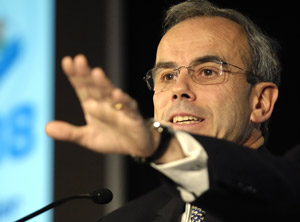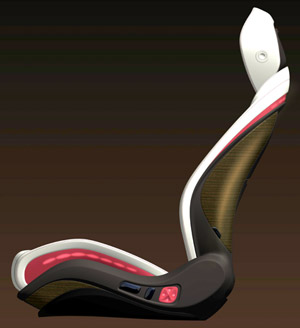FAURECIA
French automotive supplier expects revenues to reach EUR 16 bn by 2014 / 20 new plants in Asia / Cooperation with BASF and Rhodia on structural seat components
 Yann Delabriere (Photo: Faurecia) |
Looking ahead to the next four years, automotive supplier Faurecia (Nanterre / France; www.faurecia.com) CEO Yann Delabriere is not planning on completely revamping the company. The four existing business divisions “Seating”, “Interior Systems”, “Exterior” and “Emission Control” will remain as is, and there are no plans to add another. Nevertheless, Delabriere’s vision for the French automotive supplier is anything but conservative. “We are planning for revenues to reach EUR 16.5 bn by 2014,” Delabriere told a press conference on 14 June. In 2009, group sales still stood at EUR 9.3 bn.
To realise these goals – including operative margins of between 5-6% - the French supplier has to grow by an average 12% per year. As a result, Delabriere corrected his earlier predictions of 4% growth for 2010. Faurecia’s revenues now are expected to grow by 30% in H1, “significantly more than 4%” for the entire year.
Delabriere says he expects to achieve about one-third of this growth by new acquisitions, including last year’s takeover of Emcon (exhaust emissions) and Plastal. In the end, Faurecia managed to acquire Plastal’s four plants at a bargain price of EUR 24m. Together, Emcon and Plastal last generated sales of about EUR 2 bn.
To realise these goals – including operative margins of between 5-6% - the French supplier has to grow by an average 12% per year. As a result, Delabriere corrected his earlier predictions of 4% growth for 2010. Faurecia’s revenues now are expected to grow by 30% in H1, “significantly more than 4%” for the entire year.
Delabriere says he expects to achieve about one-third of this growth by new acquisitions, including last year’s takeover of Emcon (exhaust emissions) and Plastal. In the end, Faurecia managed to acquire Plastal’s four plants at a bargain price of EUR 24m. Together, Emcon and Plastal last generated sales of about EUR 2 bn.
 Prototype of a more slender seat with many more plastics components (Photo: Faurecia) |
There are no doubts about where this future growth will take place, with predictions that revenues generated outside of Europe will grow from an existing 23% to 42%. Faurecia has its sights fixed on China and Korea especially as regions where growth should be encouraged, although the supplier is also looking towards the US and Latin America. Translated into numbers, this means 11 new plants will come into being in China alone and an additional seven in Korea. Whereas the French group is planning to triple its sales in Asia, the US and Latin American market share is expected to double.
Plastics input is supposed to be strengthened in all four business divisions, even in “Emissions Control”. Here, Faurecia is banking on range extenders and the smaller engines of hybrid vehicles, whose lower operating temperatures make them increasingly accessible for plastics. Only polymers are capable of significantly reducing the weight of doors, fenders and deck lids. The segment’s market volume currently is estimated at EUR 19 bn, and Delabriere expects this to grow by 53% until 2014 – of which 16% alone will be generated by the increased use of plastics, with another 37% linked to group plans for geographic expansion.
Weight reduction also is mandatory for car interiors, although here Faurecia is taking a different track, as spokesman Olivier Le Friec told PIE. “In the current mix of polypropylene and 50% flax used for covers, the PP could be replaced by PLA or PHA, which are lighter and allow us to reach 100% recyclability.” Faurecia has already entered into a cooperation with Rhodia and BASF on seating systems, with the goal of determining how to replace the steel, used predominantly in the security-relevant structural parts, with plastics.
Plastics input is supposed to be strengthened in all four business divisions, even in “Emissions Control”. Here, Faurecia is banking on range extenders and the smaller engines of hybrid vehicles, whose lower operating temperatures make them increasingly accessible for plastics. Only polymers are capable of significantly reducing the weight of doors, fenders and deck lids. The segment’s market volume currently is estimated at EUR 19 bn, and Delabriere expects this to grow by 53% until 2014 – of which 16% alone will be generated by the increased use of plastics, with another 37% linked to group plans for geographic expansion.
Weight reduction also is mandatory for car interiors, although here Faurecia is taking a different track, as spokesman Olivier Le Friec told PIE. “In the current mix of polypropylene and 50% flax used for covers, the PP could be replaced by PLA or PHA, which are lighter and allow us to reach 100% recyclability.” Faurecia has already entered into a cooperation with Rhodia and BASF on seating systems, with the goal of determining how to replace the steel, used predominantly in the security-relevant structural parts, with plastics.
17.06.2010 Plasteurope.com [216542]
Published on 17.06.2010

 German version of this article...
German version of this article...